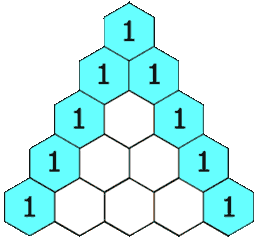英文原文
Given an integer numRows, return the first numRows of Pascal's triangle.
In Pascal's triangle, each number is the sum of the two numbers directly above it as shown:

Example 1:
Input: numRows = 5 Output: [[1],[1,1],[1,2,1],[1,3,3,1],[1,4,6,4,1]]
Example 2:
Input: numRows = 1 Output: [[1]]
Constraints:
1 <= numRows <= 30
中文题目
给定一个非负整数 numRows,生成「杨辉三角」的前 numRows 行。
在「杨辉三角」中,每个数是它左上方和右上方的数的和。

示例 1:
输入: numRows = 5 输出: [[1],[1,1],[1,2,1],[1,3,3,1],[1,4,6,4,1]]
示例 2:
输入: numRows = 1 输出: [[1]]
提示:
1 <= numRows <= 30
通过代码
高赞题解
解题思路
观察一下规律,发现当前一行只比上一行多了一个元素,最最关键的一点:本行元素等于上一行元素往后错一位再逐个相加:
 {:width=”300px”}{:align=”center”}
{:width=”300px”}{:align=”center”}
因此我们只要对最后一行单独处理:最后一行首、尾分别添加一个零然后对应位置求和就可以得到新的一行,思路上比较清晰,占用的时间、空间复杂度也都还挺好<(▰˘◡˘▰)
代码
[]class Solution: def generate(self, numRows: int) -> List[List[int]]: if numRows == 0: return [] res = [[1]] while len(res) < numRows: newRow = [a+b for a, b in zip([0]+res[-1], res[-1]+[0])] res.append(newRow) return res
统计信息
| 通过次数 | 提交次数 | AC比率 |
|---|---|---|
| 237744 | 323212 | 73.6% |
提交历史
| 提交时间 | 提交结果 | 执行时间 | 内存消耗 | 语言 |
|---|
相似题目
| 题目 | 难度 |
|---|---|
| 杨辉三角 II | 简单 |




